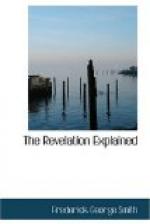With the dissolution of the earth on which we live, which event has just been described, it is evident that the many lines of prophecy leading up to that great event are no longer under special consideration, but that a new theme subsequent to the judgment scene is introduced with the words of the Revelator immediately following—“I saw a new heaven and a new earth: for the first heaven and the first earth were passed away; and there was no more sea.” The heaven, earth, and sea that passed away certainly refers to the earth that now is and to the aerial heaven surrounding it; therefore the new heaven and the new earth brought to view must signify the future and eternal home that Jesus went to prepare. We could not consistently make the one literal and the other symbolical. This accords perfectly with the teaching of the apostle Peter where he says: “The day of the Lord will come as a thief in the night; in the which the heavens shall pass away with a great noise, and the elements shall melt with fervent heat, the earth also and the works that are therein shall be burned up.... Nevertheless we, according to his promise, look for new heavens and a new earth, wherein dwelleth righteousness.” 2 Pet. 3:10-13.
The holy city of God, the New Jerusalem, is next introduced. Since this meets its fulfilment in the new order of things subsequent to the judgment scene, it must have special reference to the future abode of the saints in the new earth. Many of the symbols here describing the New Jerusalem, and even New Jerusalem itself, are often used to set forth the church of God in the New Testament dispensation. The church on earth and the church of God in heaven are in one important sense the same thing, as they constitute but one family (Eph. 3:15); yet in another sense there is a difference, and the proper distinction must be observed even when the same symbols or titles are used to describe or




